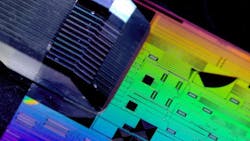MOSIS teams with imec, Tyndall, and ePIXfab on silicon photonics
Leuven, Belgium--MOSIS (Marina Del Rey, CA), a provider of low-cost prototyping and small volume production services for custom integrated circuits (ICs), teams up with ePIXfab (Gent, Belgium), the European Silicon Photonics support center providing low-cost prototyping services for photonic ICs. The partnership gives MOSIS' customers access to imec’s state-of-the-art fully integrated silicon photonics processes and the Tyndall National Institute's (Cork, Ireland) advanced silicon photonics (http://www.laserfocusworld.com/articles/print/volume-48/issue-12/features/optical-technologies-scale-the-datacenter.html) packaging technology.
Imec's silicon photonics platform enables cost-effective R&D of silicon photonic ICs for high-performance optical transceivers (25Gb/s and beyond) for telecom, datacom, and optical sensing for life science applications. The offered integrated components include low-loss waveguides, efficient grating couplers, high-speed silicon electrooptic modulators and high-speed germanium waveguide photodetectors. A comprehensive design kit to access imec technologies will be provided. Moreover, the Tyndall National Institute, being a partner of ePIXfab, offers the ability to provide packaged silicon photonics devices. This includes the design and fabrication of custom photonic packages (http://www.laserfocusworld.com/articles/2013/02/cea-leti-to-coordinate-four-year-ec-silicon-photonics-commercial.html), fiber coupling (single and arrays) and electrical interconnects. Designs rules to support these packaging capabilities will also be provided.
"Imec's Silicon Photonics platform provides robust performance, and solutions to integrated photonics products. Companies can benefit from imec silicon photonics capability through established standard cells, or explore the functionality of their own designs in MultiProject Wafer runs," said Philippe Absil, program director at imec. "With this collaboration MOSIS will offer its first access to a mature Silicon Photonics infrastructure, with the option for follow on production," added Wes Hansford, MOSIS director.
The first ePIXfab-Europractice run for passive silicon photonics ICs is open for registration from June 2013 with design deadline September 9th 2013. MOSIS' customers can register for this run and obtain the design kit via MOSIS in June 2013.
Imec's Si Photonics 200 mm wafer platform offers extensive design flexibility and includes tight within-wafer silicon thickness variation 3 sigma < 2.5nm; three-level patterning of 220nm top Si layer (193 nm optical lithography); poly-Si overlay and patterning (193 nm optical lithography); three-level n-type implants and 3-level p-type implants in Si; Ge epitaxial growth on Si and p-type and n-type implants in Ge; local NiSi contacts, tungsten vias and Cu metal interconnects; Al bond pads; validated cell library with fiber couplers, polarization rotators, highly efficient carrier depletion modulators and ultra-compact Ge waveguide photo-detectors with low dark current; design kit support for IPKISS framework, PhoeniX Software and Mentor Graphics software; Tyndall's Si Photonics Packaging Technology for passive device packaging , single and multifiber arrays to grating couplers; active device packaging, modulators and detectors with electrical ports and fiber arrays; and custom packaging requirements (mechanical, thermal stability).
Since 1981, MOSIS (http://mosis.com) has fabricated more than 50,000 circuit designs for commercial firms, government agencies, and research and educational institutions around the world.
Imec (http://www.imec.be) leverages its scientific knowledge with the innovative power of its global partnerships in ICT, healthcare and energy for industry relevant technology solutions. In a unique high-tech environment, its international top talent is committed to providing the building blocks for a better life in a sustainable society. Imec is headquartered in Leuven and has offices in Belgium, the Netherlands, Taiwan, the U.S., China, India, and Japan. Its staff of close to 2,000 people includes more than 600 industrial residents and guest researchers.
The Tyndall National Institute (http://www.tyndall.ie) is Ireland's largest research institute and performs research in the fields of photonics, nanotechnology, and microsystems. In photonics, the institute has expertise developing advanced packaging solutions for both InP and Si photonic technologies and has a state-of-the-art photonic packaging laboratory.
ePIXfab (http://epixfab.eu/) is the European Silicon Photonics Platform co-funded by the EU. ePIXfab is a consortium of partners coordinated by the Photonics Research Group, Ghent University and imec partnership. Other members of the consortium are CEA-LETI (France), IHP (Germany) TNO (Netherlands), Tyndall (Ireland) , VTT (Finland) and CMC Microsystems (Canada); providing together diverse expertise from design to packaging thus supporting the emergence of a fabless ecosystem in Si photonics.
SOURCE: imec; http://www2.imec.be/be_en/press/imec-news/mosis2013.html

Gail Overton | Senior Editor (2004-2020)
Gail has more than 30 years of engineering, marketing, product management, and editorial experience in the photonics and optical communications industry. Before joining the staff at Laser Focus World in 2004, she held many product management and product marketing roles in the fiber-optics industry, most notably at Hughes (El Segundo, CA), GTE Labs (Waltham, MA), Corning (Corning, NY), Photon Kinetics (Beaverton, OR), and Newport Corporation (Irvine, CA). During her marketing career, Gail published articles in WDM Solutions and Sensors magazine and traveled internationally to conduct product and sales training. Gail received her BS degree in physics, with an emphasis in optics, from San Diego State University in San Diego, CA in May 1986.
